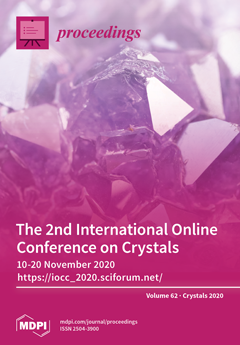Need Help?
Proceedings, 2020, IOCC 2020
The 2nd International Online Conference on Crystals
Online | 10–20 November 2020
Volume Editors:
Abel Moreno, Universidad Nacional Autonoma de Mexico (UNAM), Mexico
Dritan Siliqi, Institute of Crystallography-CNR, Italy
- Issues are regarded as officially published after their release is announced to the table of contents alert mailing list.
- You may sign up for e-mail alerts to receive table of contents of newly released issues.
- PDF is the official format for papers published in both, html and pdf forms. To view the papers in pdf format, click on the "PDF Full-text" link, and use the free Adobe Reader to open them.
Cover Story (view full-size image):
This issue of Proceedings gathers the papers that were presented at The 2nd International Online Conference on Crystals (IOCC 2020), held online on 10–20 November 2020 through the sciforum.net
[...] Read more.
This issue of Proceedings gathers the papers that were presented at The 2nd International Online Conference on Crystals (IOCC 2020), held online on 10–20 November 2020 through the sciforum.net platform developed by MDPI. IOCC 2020 is a new and improved initiative based on the experience from the 1st International Electronic Conference on Crystals (https://sciforum.net/conference/IECC_2018) which affords the opportunity for researchers engaged in the study of crystalline materials to present their research and exchange ideas with their colleagues.
Previous Issue
Next Issue
Issue View Metrics
Multiple requests from the same IP address are counted as one view.



